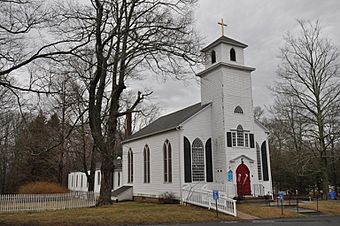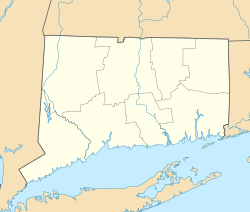Meeting House Hill Historic District facts for kids
Quick facts for kids |
|
|
Meeting House Hill Historic District
|
|

St. John's Episcopal Church
|
|
| Location | Roughly bounded by Long Hill, Great Hill, and Ledge Hill Rds., Guilford, Connecticut |
|---|---|
| Area | 16 acres (6.5 ha) |
| Built | 1812 |
| Architect | Coan, Abraham; Granbery, E. Carleton |
| Architectural style | Greek Revival, Gothic, Federal |
| NRHP reference No. | 87002132 |
| Added to NRHP | December 14, 1987 |
The Meeting House Hill Historic District is a special place in North Guilford, Connecticut. It's where two old churches, a cemetery, and a historic road come together. This area shows how people from different religious groups learned to get along in the early 1800s. It was added to the National Register of Historic Places in 1987 because of its important history.
Contents
Exploring Meeting House Hill
Meeting House Hill is found in the countryside of northern Guilford. It sits on top of a hill, which makes it easy to spot. You can reach it by Ledge Hill Road, a path that was created way back in the early 1700s. The cemetery is on the west side of the road. The church buildings are on the east side.
A Look Back: Early Days
North Guilford started as a farming area for the town of Guilford. In 1705, land was set aside for a common gathering place. Then, in 1717, more land was given for a meeting house and a cemetery. Most people in the area at that time belonged to the Congregational church. The town even collected taxes to support this church.
Later, in 1747, some people in North Guilford decided to join the Church of England (who are now called Episcopalians). They built their own church a bit further south. These new church members didn't like paying taxes to the Congregational church. This caused some disagreements in the town.
However, in the early 1800s, people decided it was time to make peace. The Congregationalists agreed to let the Episcopalians build their church right next to theirs. This showed a new spirit of understanding and tolerance between the different religious groups.
The Churches of Meeting House Hill
The district includes two main churches, along with their extra buildings like halls and homes for the ministers.
North Guilford Congregational Church
This church is the one further north. It was built between 1812 and 1814 by Abraham Coan. It's designed in the Federal style, which was popular at that time. Next to this church, you'll find a house built in 1823 for the minister. There's also a parish hall from 1887-88, which now serves as a school.
St. John's Episcopal Church
This church is located south of the Congregational church. It was also built around 1812-1814. St. John's Episcopal Church has a mix of styles, including Classical and Gothic elements. These different styles come from changes made to the building in the late 1800s and early 1900s. Near St. John's, there's a former rectory (a home for the minister) built in 1851. It's designed in the Greek Revival style.



